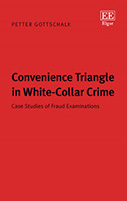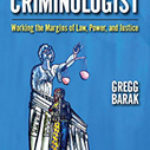Convenience Triangle In White-Collar Crime: Case Studies Of Fraud Examinations

Author: Petter Gottschalk
Publisher: Cheltenham Glos (UK): Edward Elgar Publishing, 2019. 296p.
Reviewer: Viviana I. Vasiu | May 2021
The concept of white-collar crime was coined by Edwin Sutherland in his 1939 speech to the American Sociological Society. Convenience Triangle in White-Collar Crime: Case Studies of Fraud Examinations expressly works within the parameters of Sutherland’s white-collar crime definition. Petter Gottschalk defines white-collar crime as financial crime committed by privileged individuals who have legitimate access to resources based on the power and trust inherent through their professional position. Gottschalk acknowledges that the theory at the heart of this book, which proposes that motive, opportunity, and willingness are the three dimensions that underly white-collar crime, is dependent on crime that occurs in an organizational context. This book contributes to the study of white-collar criminality through a blend of theoretical discussions and practical materials that illuminate and support the use of convenience theory.
Gottschalk’s book first introduces readers to the difficulty of detecting white-collar crime. The power and organizational opportunities that white-collar criminals possess facilitate escaping detection in various ways. Whistleblowers serve as the confidential informants that are paramount towards detection, but the retaliation they often face serves as a substantial deterrent. In fact, the author notes how Norway is one of the few countries in the world that introduced a law on the protection of whistleblowers against retaliation, though he acknowledges it is not being implemented effectively. Further, Gottschalk introduces readers to the concept of symbolic defense to show that, even when detected, white-collar criminals still have an arsenal of resources at their fingertips to avoid or mitigate consequences. Symbolic defense refers to the robust access that white-collar criminals have to effective defense attorneys and resources that enable information control and mobilization of sympathy to frame them as victims.
The author then proceeds to present extensively on the fraud examinations that are conducted once white-collar crime is detected. While Gottschalk acknowledges the usefulness of fraud examination reports, he teaches readers that these examinations often fail, and require more policing. Aside from fraud examinations running the risk of assigning blame without being confined by the rules and protections of the justice system, the individuals customarily conducting these examinations may lack the appropriate knowledge and background to interpret the facts accurately—for instance, accountants may not know enough about the psychology or sociology of white-collar criminals, and lawyers may not know how to interpret facts requiring specialized accounting knowledge.
This book ultimately revolves around the theory of convenience. The theory of convenience proposes that the triangle of motive, opportunity, and willingness are the three dimensions that underly white-collar crime. With each dimension, the author insightfully differentiates between white-collar crime and street crime to further shed light on its underpinnings. In the economic dimension (motive), the author suggests that Maslow’s hierarchy of needs is a starting point that sheds light on both the motivations for and differences between white-collar and street crime. While street crime finds its motivation in the lower levels of this hierarchy, such as to satisfy basic needs like food and housing, white-collar crime concerns itself with the higher levels, such as needs for respect and self-actualization. As such, the motivation for white-collar crime is found not only in accumulating financial wealth, but also in garnering respect and admiration. In the organizational dimension (opportunity), the author emphasizes how organizational settings offer white-collar criminals access to resources, legitimacy, and power that street criminals do not similarly enjoy. This very setting and status facilitate the concealment and execution of white-collar crime.
Finally, within the behavioral dimension (willingness), the author sets forth how white-collar criminals engage in blame games and employ neutralization techniques which, combined with oftentimes narcissistic tendencies, can lead an individual on a slippery slope from right to wrong. Common neutralization techniques consist of condemning the condemners and claiming that the law itself is unreasonable. Gottschalk’s presentation of these neutralization techniques ties harmoniously with symbolic defense where attempts at victimization are made. White-collar criminals rationalize their behavior, which both facilitates and helps cope with committing crimes, by believing that when faced with the relevant possibilities and threats, deviant behavior was the rational choice, and anyone would have proceeded similarly. White-collar criminals oftentimes display narcissistic tendencies which leads to entitlement feelings and narcissistic identification. In fact, Gottschalk includes research from the United States that supports that many white-collar criminals identify so strongly with their organization, which enables the mindset that “there really is no difference between the personal wallet and the wallet of the business.” This entitlement can make white collar criminals feel that they are above the law, and lead to the creation of a world where right and wrong is redefined in their minds. Interestingly, and on par with the neutralization mindset that Gottschalk discusses at length, white-collar criminals seldom think of themselves as “real criminals.” Indeed, a convicted white-collar criminal from Norway stated “we are all mixed in the same soup…one should never look at convicts as a homogenous group.” In a similar vein, Thomas Middelhoff, a former German CEO and convicted fraudster, expressed feelings that exemplify precisely the rationalization and neutralization explored in the behavioral dimension: “[t]hought that certain rules did not apply to me…I don’t regard myself as a criminal in the legal sense, but I do accept my sentence.”
In the first half of the book, Gottschalk also explores the special sensitivity hypothesis. This hypothesis enriches the discussion on the behavioral dimension, all while offering insight into sentencing considerations. This special sensitivity hypothesis proposes that white-collar criminals suffer at a much higher extent from incarceration than regular street criminals. Gottschalk argues that white-collar criminals are used to a certain lifestyle and status and have much more to lose, such as reputation, wealth, family, position, and professional licenses. Interestingly, some older research from the U.S. based on interviews with judges suggests that the spirit of this hypothesis influenced sentences given to white-collar criminals. To wit, many of the judges interviewed believed it was punishment enough for white-collar criminals experiencing suffering due to “apprehension, public indictment and conviction, and the collateral disabilities incident to conviction-loss of job, professional licenses, and status in the community,” and incarceration or lengthy incarceration was not necessary, unlike with street criminals: “I am not saying that if you cut everyone they don’t bleed red blood…but the white collar criminal has more to lose by going to jail.” Nevertheless, Gottschalk helpfully notes that several recent studies around the world, particularly in the United States, which analyzed victimization, prison conduct, psychological adjustment, and participation in prison programs, fail to support this hypothesis, and that in fact, white-collar criminals adapt successfully to life in prison.
Gottschalk’s book stands out by not only providing a wealth of theoretical discussion, but by supporting this discussion with a panoply of practical case studies and offender autobiographies. In fact, a substantial part of the latter half of the book consists of six case studies of white-collar cases spanning continents. For example, the author focuses on uncovering insights and rendering accessible Middelhoff’s autobiography, which is only available in German. To accomplish this, Gottschalk walks readers through the study of this autobiography through the prism of convenience theory. For the first dimension, Gottschalk illustrates how Middelhoff admitted to craving to “be in the limelight,” thus becoming a narcissist. For the second dimension, his powerful network and status allowed him to conceal and commit his crimes. Finally, for the last dimension, Gottschalk highlights the numerous neutralization techniques used by Middelhoff, such as his expressed feelings of innocence and wrongful conviction, condemning the condemners, blaming the justice system for the illness developed while incarcerated, and overall portraying himself as the victim.
The author further dedicates a chapter to exploring the causality and dynamic among the three dimensions of convenience theory through six case studies based on a synthesis of fraud examination reports, media, and court records. For instance, the author illustrates the dynamic between the behavioral dimension and the economic dimension through the Unibuss bribery scandal from Germany, wherein the bus manufacturer MAN was bribing public transportation companies and procurement officials to ensure the purchase of their busses. Gottschalk guides readers through this dynamic by explaining that the officials’ low public salaries contributed to a strong desire and feeling of entitlement that they deserved higher earnings and a better lifestyle, through the way they spent their earnings, which enhanced their willingness to be bribed, and the rationalization for their behavior.
Some of the case studies Gottschalk substantially focuses on in the latter part of his book reveal striking patterns that support the convenience theory, such as the Wells Fargo sales misconduct scandal, the Toshiba accounting misconduct, and the Fuji Xerox customer fraud. These case studies show that the first dimension was comprised of a “sales at any cost” aggressive culture chockful of incentives and pressures; the second dimension is supported by a lack of controls or awareness; and finally, the third dimension is supported by blame games from top to bottom, neutralization, corporate culture and camaraderie, and higher loyalties. Finally, these case studies and autobiographies are further supported by the author’s compilation of the few fraud examination reports publicly available, and analysis through the prism of convenience theory to create seventeen executive deviant profiles, including those of Carrie Toldsted from Wells Fargo, Hirao Tanaka from Toshiba, and Kenneth Lay from Enron.
Through the prism of convenience theory, Convenience Triangle in White-Collar Crime: Case Studies of Fraud Examinations effectively encompasses the key stages towards understanding white-collar criminality, from where it all begins in the organizational setting, to detection and fraud examination aspects, and finally, to sentencing considerations. The author’s practical examples consistently suggest that the very culture and policies present in an organization could create a level of pressure that, instead of making diamonds, can be a breeding ground for deviant behavior. And, the behavioral dimension, particularly as it pertains to neutralization, could be helpful toward sentencing and acceptance of responsibility considerations. As such, it is a useful tool for students and practitioners in the legal, criminology, and business fields. Notably, the differences showcased between white-collar crime and street crime through the use of convenience theory not only serve to enrich theoretical discussions, but also illuminate areas where policies and rules could be implemented or continually improved.
References
Kenneth Mann, Stanton Wheeler, and Austin Sarat, Sentencing the White-Collar Offender, 17 Am. Crim. L. Rev. 479, 483-87 (1980).
Viviana I. Vasiu, J.D., magna cum laude, Stetson University College of Law (2018); B.A., summa cum laude, Stetson University College of Arts and Sciences (2015). Viviana currently serves as a Trial Attorney for the Criminal Division in the Attorney General’s Honors Program. The views expressed in this article are her own and do not necessarily represent the views of the U.S. Department of Justice or the United States.


